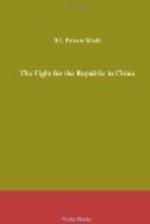CHINA’S STANDPOINT
With the same spirit of compromise and a readiness to meet the wishes of the British Government and even to the extent of making considerable sacrifices in so far as they were compatible with her dignity, China has more than once offered to renew negotiations with the British Government but the latter has up to the present declined to do so. China wants nothing more than the re-establishment of Chinese suzerainty over Tibet, with recognition of the autonomy of the territory immediately under the control of the Lhassa Government; she is agreeable to the British idea of forming an effective buffer territory in so far as it is consistent with equity and justice; she is anxious that her trade interest should be looked after by her trade agents as do the British, a point which is agreeable even to the Tibetans, though apparently not to the British; in other words, she expects that Great Britain would at least make with her an arrangement regarding Tibet which should not be any less disadvantageous to her than that made with Russia respecting Outer Mongolia.
Considering that China has claimed and exercised sovereign rights over Tibet, commanded the Tibetan army, supervised Tibetan internal administration, and confirmed the appointments of Tibetan officials, high and low, secular and even ecclesiastical, such expectations are modest enough, surely. At the present moment, with communication via India closed, with no official representative or agent present, with relations unsettled and unregulated, the position of China vis-a-vis Tibet is far from satisfactory and altogether anomalous, while as between China and Great Britain there is always this important question outstanding. An early settlement in a reciprocal spirit of give and take and giving reasonable satisfaction to the legitimate aspirations and claims of all parties is extremely desirable.
4th OUTER MONGOLIA
The world is more or less acquainted with the events in Urga in December, 1911, and the proclamation of independence of Outer Mongolia with Jetsun Dampa Hutukhtu as its ruler. By the Russo-Chinese Declaration of November 5, 1913, and the Tripartite Convention of Kiakhta of 1914 China has re-established her suzerainty over Outer Mongolia and obtained the acknowledgment that it forms a part of the Chinese territory. There remains the demarcation of boundary between Inner and Outer Mongolia which will take place shortly, and the outstanding question of the status of Tannu Uriankhai where Russia is lately reported to be subjecting the inhabitants to Russian jurisdiction and expelling Chinese traders.
The Tannu Uriankhai lands, according to the Imperial Institutes of the Tsing Dynasty, were under the control of the Tartar General of Uliasutai, the Sain Noin Aimak, the Jasaktu Khan Aimak and the Jetsun Dampa Hutkhta, and divided into forty-eight somons (tsoling). Geographically, according to the same authority, Tannu Uriankhai is bounded on the north by Russia, east by Tushetu Khan Aimak, west by the various aimaks of Kobdo, and south by Jasaktu Khan Aimak. By a Joint Demarcation Commission in 1868 the Russo Chinese boundary in respect to Uriankhai was demitted and eight wooden boundary posts were erected to mark their respective frontiers.




